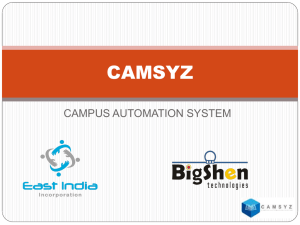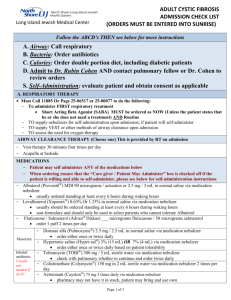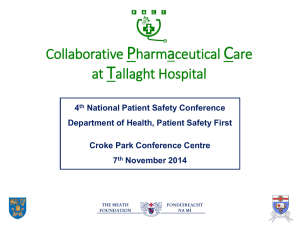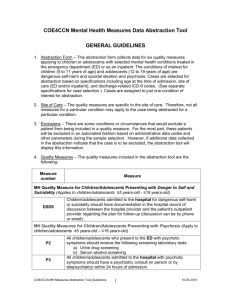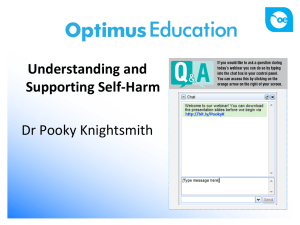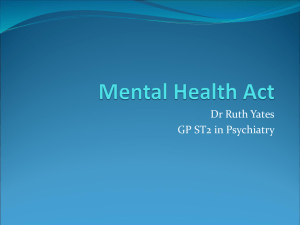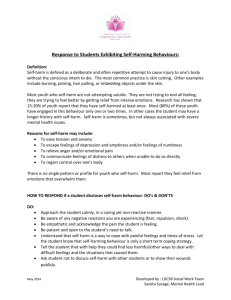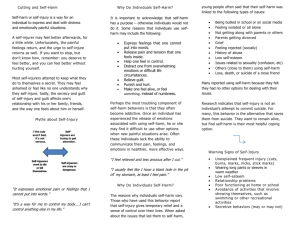EUPD%20Talk%20-%20GP%20Seminar%20of%2015%2007
advertisement
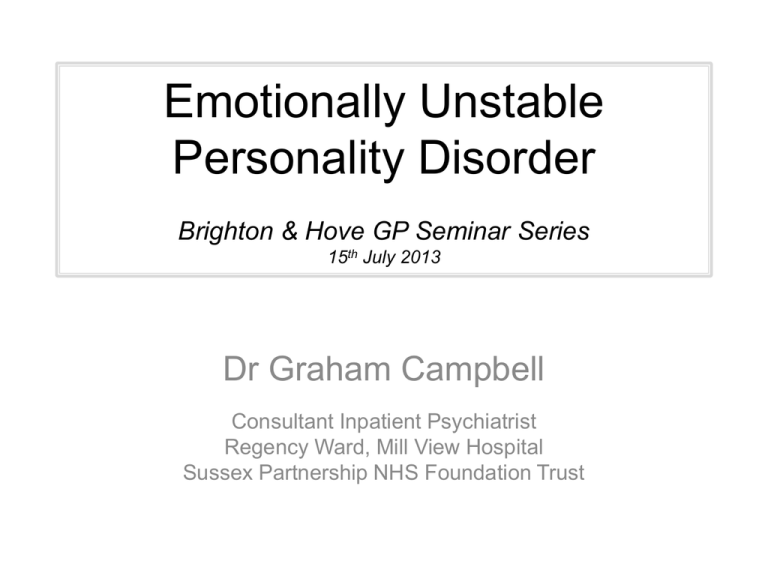
Emotionally Unstable Personality Disorder Brighton & Hove GP Seminar Series 15th July 2013 Dr Graham Campbell Consultant Inpatient Psychiatrist Regency Ward, Mill View Hospital Sussex Partnership NHS Foundation Trust GP Seminar • • • • Introductions Focus of Session Brief Tutorial with discussion Introduction to Lighthouse Recovery Support • Questions/Discussion Personality Disorder • Severe disturbance associated with considerable personal and social disruption/distress • Appears in late childhood/adolescence and continues into adulthood • Enduring and longstanding • Markedly disharmonious attitudes & behaviour – Affectivity, arousal, impulse control, ways of perceiving & thinking or relating to others • Pervasive & clearly maladaptive to a broad range of personal and social situations • Significant problems in occupational & social performance Prevalence • General population 10% • MH presentations to GP 5-8% (primary diagnosis) • Psychiatric outpatient 30-40% (not primary) • Psychiatric inpatient 40-50% (not primary) • 5-15% (primary) “ “ • Prison population 25-75% EUPD/EID • Also known as Emotional Intensity Disorder (EID) – disorder of emotional/behavioural regulation • Likely biological/genetic vulnerability (traits/temperament) • Possible familial relationship with EUPD and affective disorder • Often inconsistent emotional support, invalidating emotional environment, neglect or abuse in the person’s history • Range of partially dissociated ‘self-states’ – response to unmanageable external threats and reinforced through repeated trauma EUPD – ICD-10 • Impulsive type – Emotional instability – Marked tendency to act impulsively without consideration of the consequences (lack of self-control) – Reduced ability to plan ahead – Intense anger which can lead to violence and “behavioural explosions” EUPD – ICD-10 • Borderline type – Emotional instability – Disturbance of self-image, aims and preferences (including sexual) – Chronic feelings of emptiness – Intense & unstable relationships • Repeated emotional crises • Excessive efforts to avoid abandonment – Recurrent suicidal threats or acts of self-harm Understanding the Challenges Understanding the Challenges • • • • • Limit-setting / boundaries Medication Splitting Idealisation & denigration Pre-reflective ways of thinking – Psychic equivalence – ‘Pretend mode’ • Projection & Projective identification Understanding the Challenges Need for continuity, consistency and connectedness from services Interpersonal Challenges • Behaving out of the ordinary? – Overly worried? – Angry with the patient? – Angry with MH services? – Being taken out of role? – Loss of time boundaries • Talk to a colleague or MH worker involved with the patient Interpersonal Challenges • Narrow repertoire of intense emotions expressed • Managing panic/crisis • Staying calm, listening and neutral • Helping patient to see some situations as part of life and not reinforcing idea that all pain is to be avoided, distracted from or medicated • Managing limitations of professionals & services Managing Self-Harm • Deal with urgent health crisis • Listen • Explore the stressor to allow problem-solving and consideration of alternative coping strategies • Encourage awareness of triggers • Help the individual stay “grounded” and try and stay grounded yourself! • Sometimes positive-risk management required ‘Staging’ • Stage 1 – First/early presentation – diagnosis to be verified – Short-term previous contact with services – Admissions ideally under 2/52 • Allows for full assessment and risk management • Consideration of other MH diagnoses (eg. Substances/Depression) • Liaise with community re: future management • Plan to limit further admission frequency and duration • Consider community treatment, eg. STEPPS, PD service (Dr Connie Meijer, DoP) ‘Staging’ • Stage 2 – – – – Known to MH service with confirmed diagnosis Admissions 1-2 times in 12-month period Presenting in crisis Admission ideally < 1 week • Length of stay discussed on admission • Voluntary treatment at earliest opportunity • Review meds with community (reduce polypharmacy/benzo use) • Liaise with community team in MDT review to update risk & management plan • Review benefit of admission if self-harm on the ward (Dr Connie Meijer, DoP) ‘Staging’ • Stage 3 – – – – – Long-term MH contact Repeated presentation for admission Admissions more than twice in 12-month period Usually psychosocial stressors Admission ideally around 72 hours • Length of stay discussed on admission • Voluntary treatment at earliest opportunity (lift section on admission?) • No major change to medication • Involvement of care coordinator re: discharge plan • Review benefit of admission if self-harm on the ward (Dr Connie Meijer, DoP) Positive Risk Management (DoH 2007) • Being aware that risk can never be completely eliminated • Management plans inevitably have to include decisions that carry some risk • Positive risk-taking “balances QoL & safety needs of SU, carers and the public…considers benefits vs harm of one action over another” – Emphasises the positive aspects of what can be achieved through risk management rather than simply the avoidance of undesirable consequences The Role of Medication • NICE recommends that medication is not used for BPD or specific associated symptoms • Aim to reduce and stop chronic treatments • Only short-term (< 1/52) sedative medication • Medication role only for co-morbid diagnoses STEPPS Systems Training for Emotional Predictability and Problem-Solving • Group sessions – Psychoeducational – Emotional Management • distancing, communicating, challenging, distracting, and problem management – Behavioural Management • goal setting, healthy eating behaviors, sleep hygiene, regular exercise, leisure activities, health monitoring (e.g., medication adherence), avoiding self-harm, and interpersonal effectiveness • • • • Two facilitators Manualised 2 hour sessions Systems-based Sessions for family member, carer & professionals Recovery & Hope • STEPPS and specialist services have been shown to help people manage the more destructive and distressing aspects of their personality • Important to maintain hope when making therapeutic and risk management decisions


